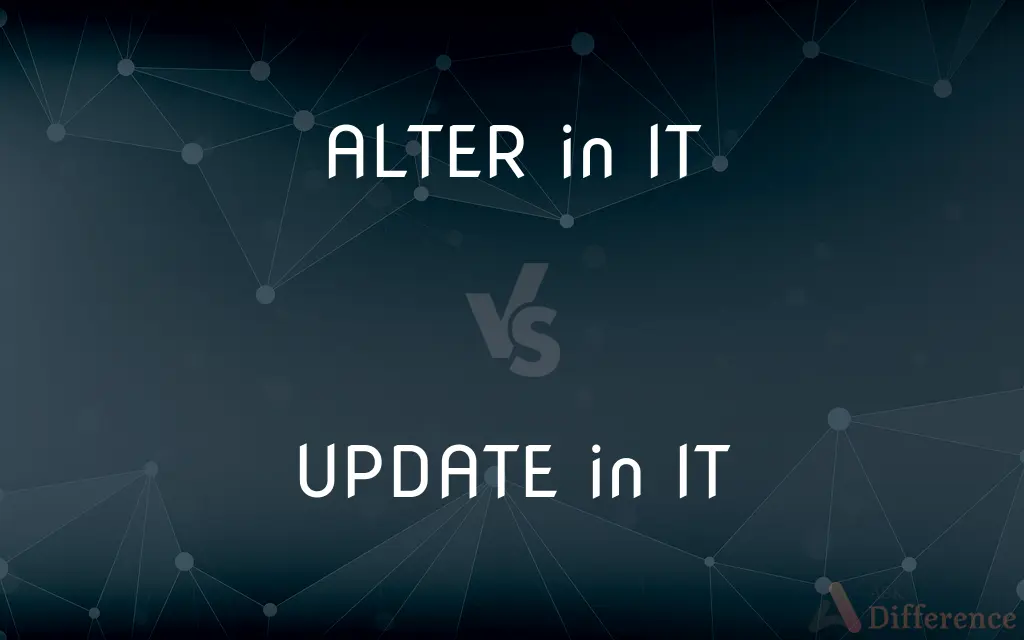ALTER in IT vs. UPDATE in IT — What's the Difference?
By Tayyaba Rehman — Published on December 21, 2023
In IT, "ALTER" usually refers to modifying the structure of a database object, while "UPDATE" pertains to changing the actual data within a database.

Difference Between ALTER in IT and UPDATE in IT
Table of Contents
ADVERTISEMENT
Key Differences
In the realm of Information Technology, specifically within databases, "ALTER" is a command used to modify the structure of an existing database object, such as a table or index. On the contrary, "UPDATE" is a command used to modify existing data within a table without changing its structure.
When dealing with database management, "ALTER in IT" allows administrators or developers to make structural changes like adding, deleting, or modifying columns in a table. "UPDATE in IT", however, lets users modify the values stored in specific rows and columns, without altering the table's foundational blueprint.
Implementing the "ALTER" command often requires careful planning and consideration, as changes to the structure might have cascading effects on related data and functions. The "UPDATE" command, being more about data manipulation, usually impacts the immediate rows of data it is applied to and may require considerations around data consistency and integrity.
"ALTER in IT" generally is about adaptability and scalability of the database, ensuring it can accommodate evolving requirements. "UPDATE in IT", in its essence, is about ensuring that the data within the database remains current, accurate, and relevant to its purpose.
It's crucial for database professionals to distinguish between these commands. Using "ALTER" when you meant to use "UPDATE" or vice versa can have unintended consequences, either causing data inconsistency or unwanted structural changes.
ADVERTISEMENT
Comparison Chart
Primary Function
Modifies the structure of database objects
Modifies the data within the database
Typical Usage
Adding/deleting/modifying columns in a table
Changing values of specific rows/columns
Scope of Impact
Structural, might impact related data/functions
Immediate rows of data it's applied to
Purpose
Adaptability and scalability of database
Ensuring data remains current and accurate
Considerations
Cascading effects on related data/functions
Data consistency and integrity
Compare with Definitions
ALTER in IT
Command to change the structure of a database object.
Using ALTER, she added a new column to the table.
UPDATE in IT
A method to adjust values in specific rows and columns.
With an UPDATE statement, he corrected the pricing errors.
ALTER in IT
Procedure to adjust characteristics of database entities.
The DBA applied ALTER to change the data type of the column.
UPDATE in IT
Instruction to make data alterations in databases.
Following the feedback, they issued an UPDATE to rectify the discrepancies.
ALTER in IT
Instruction to make structural adaptations in databases.
To accommodate the new requirements, ALTER was employed to tweak the table's structure.
UPDATE in IT
Command to modify existing data within a table.
She used UPDATE to change the customer's address.
ALTER in IT
A method to modify, add, or drop columns in a table.
He utilized ALTER to remove the obsolete column.
UPDATE in IT
Procedure to ensure data in the database remains relevant.
Regular UPDATE commands keep the inventory data accurate.
ALTER in IT
A way to transform the foundational aspects of a table or index.
The team used ALTER to rename the table for clarity.
UPDATE in IT
A way to modify information without altering table structure.
The admin ran an UPDATE to synchronize the records.
Common Curiosities
Can I use ALTER to change data values in a table?
No, ALTER is for structural changes; use UPDATE to modify data values.
Can UPDATE in IT be used to add new columns?
No, UPDATE is for data modification; use ALTER to add new columns.
Is it risky to use the ALTER command frequently?
Frequent use of ALTER can be risky as it may impact related data and functions; planning is essential.
What considerations are vital when using ALTER?
When using ALTER, consider cascading effects on related data, functions, and potential downtime.
Can ALTER rename a table?
Yes, the ALTER command can be used to rename a table or its columns.
Can UPDATE in IT modify multiple rows at once?
Yes, UPDATE can modify multiple rows based on the conditions specified in the command.
Do I need to backup before using ALTER?
It's a good practice to backup before using ALTER to safeguard against unintended changes or loss.
What happens if I misuse the ALTER command?
Misusing ALTER can lead to data inconsistency, loss, or unwanted structural changes in the database.
What is ALTER in IT used for?
ALTER in IT is used to modify the structure of an existing database object, like a table or index.
How does UPDATE in IT differ from ALTER?
UPDATE in IT modifies the actual data within a table, while ALTER changes the table's structure.
Does UPDATE in IT affect the overall database performance?
Excessive use of UPDATE can impact performance, especially on large tables; it's essential to monitor and optimize.
In which scenarios is UPDATE in IT most commonly used?
UPDATE in IT is commonly used in scenarios where data needs to be corrected, synchronized, or made current.
How can I reverse an UPDATE operation?
Unless there's a backup or a logging mechanism in place, reversing an UPDATE operation can be challenging.
Share Your Discovery

Previous Comparison
Tennis Shoes vs. Running Shoes
Next Comparison
Pascal Case vs. Camel CaseAuthor Spotlight
Written by
Tayyaba RehmanTayyaba Rehman is a distinguished writer, currently serving as a primary contributor to askdifference.com. As a researcher in semantics and etymology, Tayyaba's passion for the complexity of languages and their distinctions has found a perfect home on the platform. Tayyaba delves into the intricacies of language, distinguishing between commonly confused words and phrases, thereby providing clarity for readers worldwide.













































